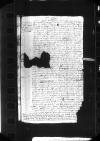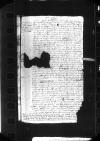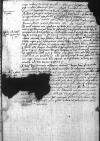Accepi ⌊⌋ regias et superinscribed⌈regias etregias et superinscribed⌉ Dominationis Vestrae Reverendissimae ab hoc ⌊cubiculario⌋, qui post absolutum iudiciarium conventum me repperit ⌊Elbingi⌋, ubi adhuc reverendissimus ⌊dominus Culmensis⌋ cum ⌊nuntio Thoronensium⌋ aderat. Cum superinscribed⌈CumCum superinscribed⌉ illis itaque et quibusdam ex ⌊magistratu Elbingensi⌋ ⌊⌋ regias legi, [dominus] enim castellanus Gdanensis eo, [q]uod in causis non omnia, [u]t ipse volebat, cesserant, [no]n salutato ut se cum domino a Baisen, succamerario Marienburgensi, subduxerat quod on the margin⌈dominus hidden by binding⌈[dominus]dominus hidden by binding⌉ enim superinscribed⌈enimenim superinscribed⌉ ⌊castellanus Gdanensis⌋ eo, q hidden by binding⌈[q]q hidden by binding⌉uod in causis non omnia, u hidden by binding⌈[u]u hidden by binding⌉t ipse volebat, cesserant, no hidden by binding⌈[no]no hidden by binding⌉n salutato ut se cum ⌊domino a Baisen⌋, succamerario Marienburgensi, subduxerat quod[dominus] enim castellanus Gdanensis eo, [q]uod in causis non omnia, [u]t ipse volebat, cesserant, [no]n salutato ut se cum domino a Baisen, succamerario Marienburgensi, subduxerat quod on the margin⌉. Post litterarum lectionem non parum attonitus ⌊dominus Culmensis⌋, eo quod ⌊magistratum Gdanensem⌋, cuius ⌊nuntii⌋ iam discesserant, citatum ad tribunal regium intellexerat, consilium dedit, ut, transmissis regiarum litterarum exemplis ad alios ⌊dominos consiliarios⌋, illis suggereretur petendum esse a serenissima ⌊maiestate regia⌋ negotium Pucense ad ⌊comitia⌋ hic verna remitti, ut tum in commune fieret deliberatio superinscribed in place of crossed-out consultatio⌈consultatiodeliberatiodeliberatio superinscribed in place of crossed-out consultatio⌉, quid in eo serenissimae maiestati on the margin⌈maiestatimaiestati on the margin⌉ regiae agendum veniret neque fieri posse, ut tam brevi tempore deligi posse nuntios, qui plena facultate fulti, causam Pucensem interessent eamque nomine omnium consiliariorum, qui eo venire nequirent, apud serenissimam maiestatem regiam tractarent, et esse neminem ex consiliariis, qui adeo gravem provinciam sub plena faculate, quae etiam sine periculo non daretur, tuto susciperet etc. Tende.
Tendebat [...] paper damaged⌈[...][...] paper damaged⌉ tota eius oratio, ut nuntii non mitterentur, sed ut [...] paper damaged⌈[...][...] paper damaged⌉or peteretur causam hanc in ⌊conventum⌋ hic [...] paper damaged⌈[...][...] paper damaged⌉ reici differri, quod ad eum modum cum [...] paper damaged⌈[...][...] paper damaged⌉ litterarum ad alios ⌊dominos consiliarios⌋ est [...] paper damaged⌈[...][...] paper damaged⌉, n paper damaged⌈[n]n paper damaged⌉on obstante quod dicerem eiusmodi dilationem [...] paper damaged⌈[...][...] paper damaged⌉ vix umquam impetraturos, quae secundum prius [...] paper damaged⌈[...][...] paper damaged⌉ n paper damaged⌈[n]n paper damaged⌉obiscum vel cum superinscribed in place of crossed-out per⌈per cum cum superinscribed in place of crossed-out per⌉ nuntii written over o⌈oii written over o⌉s nostri written over o⌈oii written over o⌉s negotium hoc discutiendum se offerret hic itaque ad oportereque nos intendere, ne nos ipsi privilegiis nostris derogaremus etc.
S written over H(?)⌈H(?)SS written over H(?)⌉ic inter nos fuit discessum.
Quid subsequetur, cum ⌊dominus Culmensis⌋ cum Gdanensibus on the margin⌈cum Gdanensibuscum Gdanensibus on the margin⌉ maiorem fere fere partem ⌊consiliariorum⌋ sibi devinxit, paulo post ex sententiis et votis illorum, quae ad me perscribi debent, experiat. De iis et aliis rebus fortassis superinscribed⌈fortassisfortassis superinscribed⌉ coram, Deo concedente superinscribed in place of crossed-out praestante⌈praestante concedente concedente superinscribed in place of crossed-out praestante⌉, fusius. Quandoquidem non superinscribed in place of crossed-out Non⌈NonQuandoquidem nonQuandoquidem non superinscribed in place of crossed-out Non⌉ est, quod ⌊principi meo⌋ negare liceat, a quo habeo, quicquid indulgentia dedit Divina, neque me remorabuntur debita, quibus ob priores profectiones sum involutus, neque superinscribed in place of crossed-out quin⌈quinnequeneque superinscribed in place of crossed-out quin⌉ etiam affecta valetudo written over ine⌈ineoo written over ine⌉, quae tamen non parum quam prius firmior facta est, quin pientissimum dominum meum et Dominationem Vestram Reverendissimam pro singulari amore meo superinscribed⌈meomeo superinscribed⌉ et observantia, qua illam prosequor, reverenter videam et dulcissima eius fruar consuetudine. Consilii porro et prudentiae, quae mihi tribuitur, nihil in me sentio. Pro Supervacaneum etenim et inutilem written over i⌈iemem written over i⌉ servum written over o⌈omm written over o⌉ me domino meo me superinscribed⌈meme superinscribed⌉ esse existimo. Quodcumque tamen de written over a⌈a de de written over a⌉ me praebere possum, quod gratum et commodum esse putabitur, omni fert diligentia et fide praesta paper damaged⌈[ta]ta paper damaged⌉bo adscribed in place of crossed-out bitur⌈biturbobo adscribed in place of crossed-out bitur⌉.
Reliquum dicet scheda adque hoc praescriptum, ut p[...] paper damaged⌈[...][...] paper damaged⌉ scheda, sub superinscribed in place of crossed-out pro⌈pro sub sub superinscribed in place of crossed-out pro⌉ mutua inter nos confisione habeat a Dominatione [...] paper damaged⌈[...][...] paper damaged⌉ Vestra Reverendissima maiorem in modum oro. Cui et commendatissimus esse cupio paper damaged⌈[cupio]cupio paper damaged⌉, et on the margin⌈etet on the margin⌉ omnia precor faustissima.
Reverendissime mi Domine,
Per ⌊cubicularium regium⌋, qui litteras Dominationis Vestrae Reverendissimae mihi reddidit, generosum dominum paper damaged⌈[ominum]ominum paper damaged⌉ ⌊castellanum paper damaged⌈[castellanum]castellanum paper damaged⌉ Elbingensem⌋, qui iam abierat, rogavi, ut rursum ad me ⌊Elbingum⌋ concederet, quod sequenti paper damaged⌈[equenti]equenti paper damaged⌉ die non gravate cum eo de citatione contuli visumque nobis fuit, ut sine mora [...] paper damaged⌈[...][...] paper damaged⌉taretur in ea, licet commendatoriae non fiat diserte mentio, vocantur tamen citati  AAWO, AB, D. 7, f. 52r ad ea paper damaged⌈[ad ea]ad ea paper damaged⌉, quae in citatione exprimuntur, et ad omnia alia in termino obiicenda respon hidden by binding⌈[on]on hidden by binding⌉suri, quae clausula ad multa commodabit. Ego quidem, ut ingenue fatear, ob hidden by binding⌈[b]b hidden by binding⌉ seram parsimoniam, quae iam in fundo est, velim non esse vocatus (suspi hidden by binding⌈[pi]pi hidden by binding⌉ciones et
odia contra me concepta, nihil moror, quod adventu meo, sicut hidden by binding⌈[icut]icut hidden by binding⌉ scribit Dominatio Vestra Reverendissima, dilui possint), verum ⌊domino meo⌋, praeterea et commonitioni hidden by binding⌈[oni]oni hidden by binding⌉ Dominationis Vestrae Reverendissimae nihil negandum esse putavi. Venturus sum igitur, quemadmodum hidden by binding⌈[um]um hidden by binding⌉ serenissimae ⌊maiestati regiae⌋ ⌊⌋. Esset item non abs re, ut dominus ⌊castellanus Elbingensis⌋ mecum hidden by binding⌈[cum]cum hidden by binding⌉ veniret, sed quasi aliis in rebus a ⌊maiestate regia⌋ vocatus. Hoc ut Dominatio Vestra Reverendissima efficiat, plurimum rogo. Accedet negotiis agendis admodum commodus.
AAWO, AB, D. 7, f. 52r ad ea paper damaged⌈[ad ea]ad ea paper damaged⌉, quae in citatione exprimuntur, et ad omnia alia in termino obiicenda respon hidden by binding⌈[on]on hidden by binding⌉suri, quae clausula ad multa commodabit. Ego quidem, ut ingenue fatear, ob hidden by binding⌈[b]b hidden by binding⌉ seram parsimoniam, quae iam in fundo est, velim non esse vocatus (suspi hidden by binding⌈[pi]pi hidden by binding⌉ciones et
odia contra me concepta, nihil moror, quod adventu meo, sicut hidden by binding⌈[icut]icut hidden by binding⌉ scribit Dominatio Vestra Reverendissima, dilui possint), verum ⌊domino meo⌋, praeterea et commonitioni hidden by binding⌈[oni]oni hidden by binding⌉ Dominationis Vestrae Reverendissimae nihil negandum esse putavi. Venturus sum igitur, quemadmodum hidden by binding⌈[um]um hidden by binding⌉ serenissimae ⌊maiestati regiae⌋ ⌊⌋. Esset item non abs re, ut dominus ⌊castellanus Elbingensis⌋ mecum hidden by binding⌈[cum]cum hidden by binding⌉ veniret, sed quasi aliis in rebus a ⌊maiestate regia⌋ vocatus. Hoc ut Dominatio Vestra Reverendissima efficiat, plurimum rogo. Accedet negotiis agendis admodum commodus.
Si nostri nuntios mittent, ut in litteris attigi (apud me adhuc in dubio hidden by binding⌈[io]io hidden by binding⌉ est), vel quicquid in eo statuerint, de me tractabitur on the margin, in the hand of Dantiscus⌈vel quicquid in eo statuerint, de me tractabiturvel quicquid in eo statuerint, de me tractabitur on the margin, in the hand of Dantiscus⌉, ut itaque adventus meus et domini ⌊castellani Elbingensis⌋, ne passim sciatur, occultus sit, non puto ob multas rationes inutile. Quantum ⌊dominus Culmensis⌋ pro suis laboret omnesque exquirat modos, ut illis prosit et obsit regiis rebus, scribi nequit, neque minori in hoc studio hidden by binding⌈[o]o hidden by binding⌉ intendit ⌊castellanus Gdanensis⌋, habentque suas factiones, immemores, quod domino suo debeant. Quod aperte liquet in litteris, quibus consilium contra rebelles dare debuerant, accusantes fere ⌊maiestatem regiam⌋ et suo written over a⌈aoo written over a⌉s quasi iniuriam passos excusantes, hocque non sine quibusdam minis, ob mul hidden by binding⌈[l]l hidden by binding⌉titudinem variae et promiscuae plebis non secus atque illa contra ⌊Regnum⌋ posset insurgere et [...] paper damaged⌈[...][...] paper damaged⌉, (s paper damaged⌈[s]s paper damaged⌉i diis placet) vim qua paper damaged⌈[a]a paper damaged⌉nda paper damaged⌈[a]a paper damaged⌉m inferre hidden by binding⌈[e]e hidden by binding⌉. Nequeo satis mirari [...] paper damaged⌈[...][...] paper damaged⌉ con paper damaged⌈[con]con paper damaged⌉fidentiam, ne dicam [...] paper damaged⌈[...][...] paper damaged⌉ [...] paper damaged⌈[...][...] paper damaged⌉tant se ⌊maiestati regiae⌋ et domin[...] paper damaged⌈[...][...] paper damaged⌉ habent pro stip[...] paper damaged⌈[...][...] paper damaged⌉ velint persuasuros [...] paper damaged⌈[...][...] paper damaged⌉edi[...] paper damaged⌈[...][...] paper damaged⌉
⌊m(aiesta)te(m) or maiestate⌈m(aiesta)te(m)m(aiesta)te(m) or maiestate⌉ regia(m) or regia⌈regia(m)regia(m) or regia⌉⌋ ante meum exitum paper damaged⌈[itum]itum paper damaged⌉ [...] paper damaged⌈[...][...] paper damaged⌉tur, quod ex litteris eorum paper damaged⌈[um]um paper damaged⌉ [...] paper damaged⌈[...][...] paper damaged⌉ sit, quantum contra ⌊maiestatem regiam paper damaged⌈[regiam]regiam paper damaged⌉⌋ [...] paper damaged⌈[...][...] paper damaged⌉ et rebus regiis inco[...] paper damaged⌈[...][...] paper damaged⌉ [...] paper damaged⌈[...][...] paper damaged⌉ur, ut [...] paper damaged⌈[...][...] paper damaged⌉nen(?) [...] paper damaged⌈[...][...] paper damaged⌉titi et fidei suae meminerint, ne quid aliud contra eos vicissim iure optimo, quod non velit maiestas regia superinscribed, in the hand of Dantiscus⌈maiestas regiamaiestas regia superinscribed, in the hand of Dantiscus⌉ statuere, inducatur.
Expostulatorias litteras de commendaticiis ex ⌊Graudencio⌋ nuper datis ⌊domin(us) Culmensis hidden by binding⌈[ensis]ensis hidden by binding⌉⌋ leviusculas esse dicebat neque responsione dignas. Ego tamen, si reliqui hidden by binding⌈[qui]qui hidden by binding⌉ nollent me pro fide et honore meo conservando responsurum, dicebam addens, nos admodum faciles quacumque etiam in re, maxime quae ⌊maiestati regiae⌋ grata esse non posset, solere dare commendaticias [...] hidden by binding⌈[...][...] hidden by binding⌉re itaque, ut deinceps aula eas explodat. ⌊Ille⌋ hoc dictum pro ioco excepit, non versatus in aula et nescius, quid in ea coquatur. Eget ob id, ut penitius eam agnoscat, acriore quodam vellicatu. Quod certo in bonam ⌊illius⌋ partem scribo, nollem enim, ut in ea, quam sibi tribuit, libertate, gravius aliquando impingeret.
Apud ⌊vicinum⌋ est eius ex ⌊fratre⌋ ⌊nepos⌋, quem in titulo scribit ducem ⌊Prussiae⌋. Il hidden by binding⌈[l]l hidden by binding⌉li venisse obviam feruntur mille quingenti cum equitibus pedites. Quid cum illo et sororio[1] tractatur, nondum comperi. Dabitur hidden by binding⌈[tur]tur hidden by binding⌉ opera ad expi<s>candum aliquid, accepi tamen, quod de matrimonio quodam agitur hidden by binding⌈[ur]ur hidden by binding⌉ et quod brevi ad vos sint ituri. Quicquid compertius habuero, postquam hidden by binding⌈[am]am hidden by binding⌉ postquam nuntius redierit, cum illo Dominationem Vestram reddam certiorem.
Quam impense oro, ut ea, quae videbuntur ex iis, quae scripsi, non indigna scientiae hidden by binding⌈[iae]iae hidden by binding⌉ serenissimae ⌊maiestatis regiae⌋, referre velit et ⌊⌋ meas ad eius maiestatem sine arbitris legere, praesertim ne adsit ⌊primas⌋, quem intellexi non parum mihi esse infensum, et hoc ob negotium Pucense, in quo haud hidden by binding⌈[d]d hidden by binding⌉ dubie Dominatio Vestra Reverendissima written over me⌈meReverendissimaReverendissima written over me⌉ mecum patitur. At cedendum non est, sed contraeundum audentius. Si Dominus Deus faverit, coram de omnibus securius cum Dominatione hidden by binding⌈[Dominatione]Dominatione hidden by binding⌉ Vestra Reverendissima dabitur colloquium.
Cui me iterum atque written over ite⌈ite atque atque written over ite⌉ iterum amicissime et intime commendo etc.
 AAWO, AB, D. 7, f. 52r ad ea paper damaged⌈[ad ea]ad ea paper damaged⌉, quae in citatione exprimuntur, et ad omnia alia in termino obiicenda respon hidden by binding⌈[on]on hidden by binding⌉suri, quae clausula ad multa commodabit. Ego quidem, ut ingenue fatear, ob hidden by binding⌈[b]b hidden by binding⌉ seram parsimoniam, quae iam in fundo est, velim non esse vocatus (suspi hidden by binding⌈[pi]pi hidden by binding⌉ciones et
odia contra me concepta, nihil moror, quod adventu meo, sicut hidden by binding⌈[icut]icut hidden by binding⌉ scribit Dominatio Vestra Reverendissima, dilui possint), verum
AAWO, AB, D. 7, f. 52r ad ea paper damaged⌈[ad ea]ad ea paper damaged⌉, quae in citatione exprimuntur, et ad omnia alia in termino obiicenda respon hidden by binding⌈[on]on hidden by binding⌉suri, quae clausula ad multa commodabit. Ego quidem, ut ingenue fatear, ob hidden by binding⌈[b]b hidden by binding⌉ seram parsimoniam, quae iam in fundo est, velim non esse vocatus (suspi hidden by binding⌈[pi]pi hidden by binding⌉ciones et
odia contra me concepta, nihil moror, quod adventu meo, sicut hidden by binding⌈[icut]icut hidden by binding⌉ scribit Dominatio Vestra Reverendissima, dilui possint), verum 


